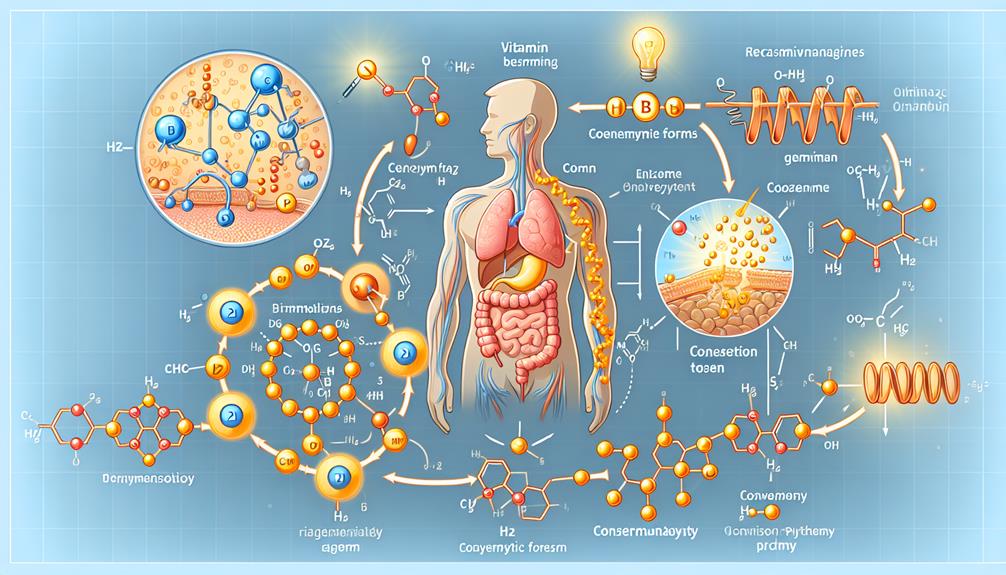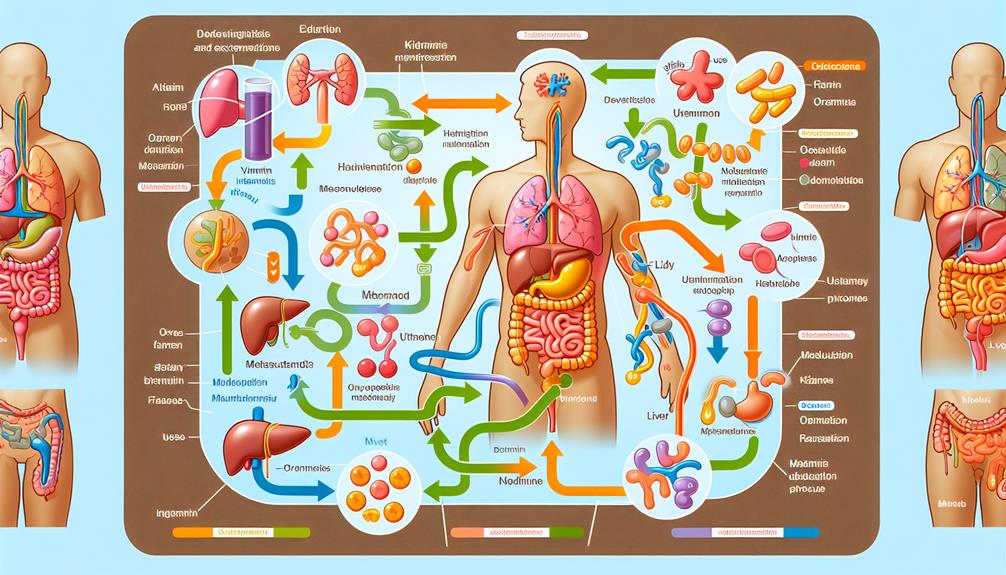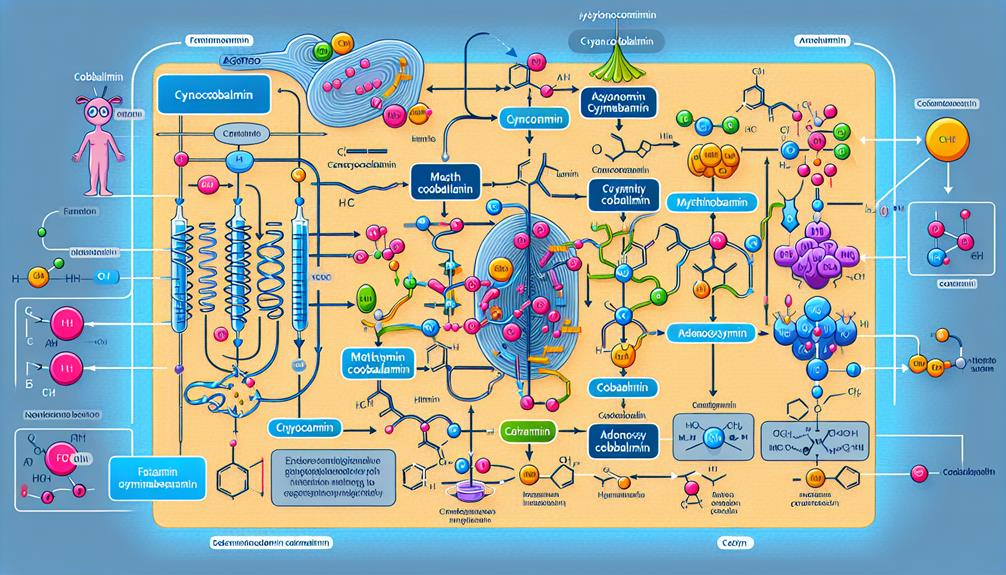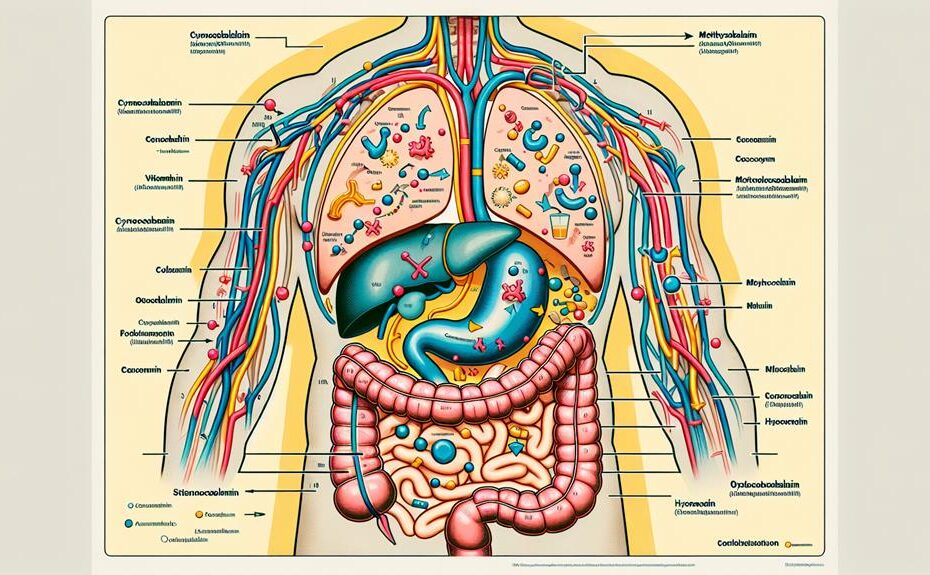







Your body absorbs Vitamin B12 through a complex process in the small intestine. It converts to active coenzyme forms like methylcobalamin for metabolic functions. Cellular uptake and enzymatic reactions are essential for its utilization in pathways such as methionine synthesis. Vitamin B12 is recycled or excreted through bile and feces when not needed. Distinct forms of B12 are key for various health aspects like nerve function and detoxification. Understanding these metabolic pathways helps in choosing suitable supplements for best health and well-being. Further insights into B12 metabolism shed light on its critical roles in your body.
Key Takeaways
- Different forms of vitamin B12 are converted to active coenzyme forms in cells.
- Enzymatic reactions in cytoplasm and mitochondria play a role in forming active coenzymes.
- Active coenzymes are crucial for metabolic conversions in various pathways.
- Cellular uptake processes ensure vitamin B12 utilization in key metabolic reactions.
- Understanding metabolic differences helps select appropriate B12 supplements for optimal health.
Absorption of Vitamin B12
When ingested, vitamin B12 is absorbed in the small intestine through a complex mechanism involving multiple steps. The process begins with vitamin B12 binding to haptocorrin in the stomach, which protects it from degradation by stomach acid. As the food moves into the small intestine, pancreatic enzymes degrade haptocorrin, releasing vitamin B12. Here, intrinsic factor, a glycoprotein secreted by the parietal cells of the gastric mucosa, binds to vitamin B12, forming a complex that can be recognized by receptors in the terminal ileum for absorption.
The absorption of vitamin B12 is highly dependent on the presence of gut microbiota, which play a vital role in processing vitamin B12 and making it available for absorption. Genetic variations can also impact the metabolism of vitamin B12, affecting the efficiency of absorption in the small intestine. Factors such as age, certain medications, and underlying health conditions can further influence the absorption of vitamin B12 in the body.
Transport Mechanisms in the Body
Transport mechanisms in the body involve the intricate movement of vitamin B12 through various physiological pathways to reach target tissues and organs for utilization. After absorption in the small intestine, vitamin B12 binds to a carrier protein known as transcobalamin II (TCN2). This protein-bound form of vitamin B12 is essential for its transport to tissues throughout the body. The metabolic pathways responsible for the distribution of vitamin B12 involve the release of the vitamin from TCN2 once it reaches the target cells.
In the bloodstream, vitamin B12 binds to specific cell surface receptors, facilitating its entry into cells. Once inside the cells, vitamin B12 can participate in various metabolic reactions important for energy production, DNA synthesis, and nerve function. The protein binding of vitamin B12 plays a significant role in protecting the vitamin from degradation and ensuring its efficient delivery to tissues where it is needed. Understanding these transport mechanisms is fundamental in elucidating how vitamin B12 is utilized by the body to support essential physiological processes.
Conversion to Active Coenzyme Forms

Following the cellular uptake of vitamin B12 facilitated by specific cell surface receptors, the next critical step involves its conversion to active coenzyme forms within the cells. Once inside the cell, vitamin B12 undergoes enzymatic reactions to form active coenzymes that play essential roles in various biochemical pathways. These coenzymes are important for metabolic conversions that are necessary for energy production, DNA synthesis, and neurological function.
The conversion of vitamin B12 to its active coenzyme forms primarily occurs in the cytoplasm and mitochondria of cells. Enzymes such as methylmalonyl-CoA mutase and methionine synthase play key roles in these processes. Methylcobalamin, adenosylcobalamin, and hydroxocobalamin are some of the active coenzyme forms that vitamin B12 is converted into, each serving specific functions within the body.
Through these intricate enzymatic reactions and coenzyme formations, vitamin B12 becomes biologically active and can participate in important metabolic pathways. Understanding this conversion process is essential for appreciating the significance of vitamin B12 in maintaining overall health and well-being.
Cellular Uptake and Utilization
Upon entering the cell through specific receptors, vitamin B12 undergoes a series of enzymatic reactions to convert into active coenzyme forms essential for metabolic processes. The cellular uptake of vitamin B12 is a tightly regulated process critical for ensuring its utilization in various metabolic pathways. Cells exhibit varying uptake efficiency for different forms of vitamin B12, with methylcobalamin and adenosylcobalamin being the most readily absorbed forms. Once inside the cell, vitamin B12 is transported to the mitochondria, where it serves as a cofactor for enzymes involved in key metabolic reactions.
The metabolic pathways where vitamin B12 plays a significant role include methionine synthesis, nucleotide biosynthesis, and fatty acid metabolism. Methionine synthesis is particularly important as it impacts DNA methylation and protein synthesis. Additionally, vitamin B12 is essential for converting methylmalonyl-CoA to succinyl-CoA, a crucial step in the citric acid cycle. Understanding the cellular uptake and utilization of vitamin B12 is fundamental in appreciating its significance in maintaining various metabolic processes within the body.
Recycling and Excretion Processes

During the metabolic processes of vitamin B12, the body efficiently recycles and excretes excess or unusable forms to maintain ideal levels for cellular functions. The recycling efficiency of vitamin B12 is a critical aspect of its metabolism. In the body, vitamin B12 that is not immediately needed is stored in the liver bound to a protein called transcobalamin II. This stored form can be released and reabsorbed multiple times to support cellular functions. However, when excess or unusable forms of vitamin B12 accumulate, the body eliminates them through excretion pathways. The main excretion pathway for vitamin B12 is through bile, where it is then eliminated in feces. In cases where there is a significant excess of vitamin B12, a small amount may also be excreted through urine. Understanding the intricate balance between recycling efficiency and excretion pathways is essential for maintaining ideal levels of vitamin B12 in the body and ensuring proper cellular function.
Factors Influencing Metabolism
To understand the metabolism of vitamin B12 more thoroughly, various factors play an essential role in influencing its efficiency and effectiveness within the body's biochemical processes. Genetics play a significant role in how efficiently your body metabolizes vitamin B12. Certain genetic variations can impact the enzymes responsible for processing B12, potentially leading to decreased absorption or utilization. Additionally, your dietary choices play a critical role in B12 metabolism. Consuming foods rich in B12, such as meat, fish, and dairy products, can enhance absorption and utilization of this vitamin.
Age is another factor that influences B12 metabolism. As you grow older, the efficiency of absorbing and utilizing B12 may decrease, leading to a higher risk of deficiency. Moreover, various medical conditions can impact B12 metabolism. Conditions like pernicious anemia or gastrointestinal disorders can hinder the body's ability to absorb B12 efficiently, necessitating alternative methods of supplementation. Understanding these factors is essential in optimizing B12 metabolism and ensuring adequate levels of this essential vitamin in your body.
Comparison of B12 Forms

Different forms of vitamin B12 exhibit distinct chemical structures and properties that influence their metabolism within the human body. When comparing B12 forms, bioavailability is an essential factor. Methylcobalamin and adenosylcobalamin, the active forms of vitamin B12, are more readily absorbed and utilized by the body compared to cyanocobalamin, a synthetic form commonly found in supplements. This higher bioavailability is due to the body's ability to directly utilize the active forms without the need for conversion.
Metabolic pathways also differ depending on the form of vitamin B12. Cyanocobalamin requires enzymatic conversion to its active forms, methylcobalamin and adenosylcobalamin, before being utilized in essential biochemical reactions. This conversion process can be inefficient in some individuals, leading to potential issues with B12 deficiency. On the other hand, methylcobalamin and adenosylcobalamin can enter the metabolic pathways directly, bypassing the need for conversion and potentially providing more immediate benefits.
Understanding the differences in bioavailability and metabolic pathways among different forms of vitamin B12 can help individuals make informed choices when selecting supplements or dietary sources to ensure sufficient B12 intake for ideal health.
Implications for Health and Wellness
Understanding the implications for health and wellness associated with the metabolism of different forms of vitamin B12 is essential for optimizing nutritional intake and overall well-being. The metabolic pathways of various B12 forms impact their bioavailability and utilization in the body, influencing overall health outcomes. Cyanocobalamin, the synthetic form commonly found in supplements, requires conversion to methylcobalamin or adenosylcobalamin for cellular utilization. Methylcobalamin, the active form of B12, plays an important role in DNA synthesis, red blood cell formation, and neurological function, offering significant nutritional benefits.
Adequate levels of methylcobalamin support nerve health, cognitive function, and energy metabolism. In contrast, hydroxocobalamin, another natural form of B12, is involved in detoxification processes and may be beneficial in treating cyanide poisoning. By understanding the metabolic differences between B12 forms, individuals can make informed decisions regarding supplementation and dietary choices to support optimal health and wellness. Incorporating a variety of B12 forms through dietary sources or supplements can ensure that the body receives the necessary nutrients to function at its best.





